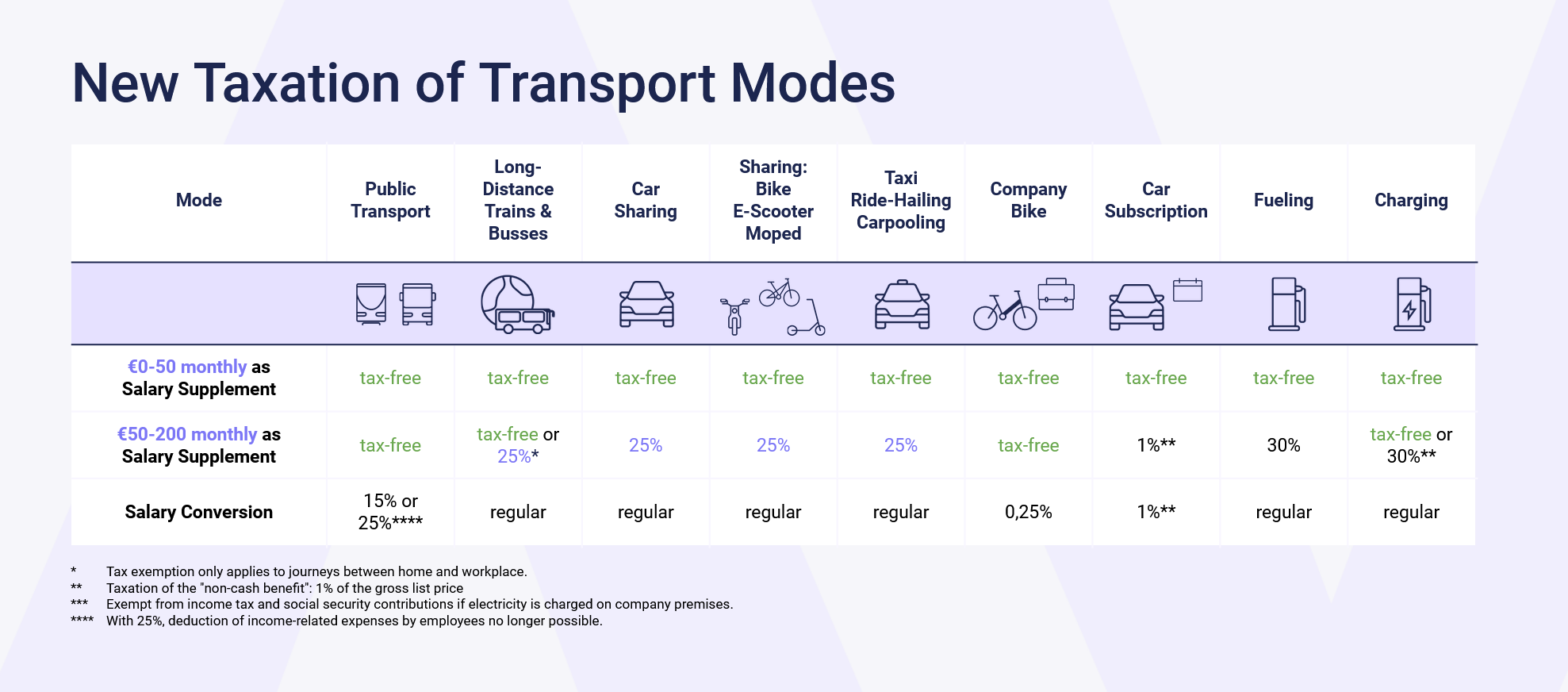
The introduction of flat-rate taxation of mobility budgets is imminent: which mobility services and means of transport are covered by the new tax regime for mobility budgets? And which are not? - An overview
"With the mobility budget, employees receive a monthly mobility credit from their employer, which they can use flexibly for the mobility services of their choice."
The 2024 Annual Tax Act is the first time that the term "mobility budget" is used in law. The tax regulations for mobility budgets will thus be considerably simplified and made more attractive for companies in order to reduce application hurdles and reservations.
The new tax regulation allows employers to levy a flat rate of 25% wage tax on a mobility budget for the use of mobility services outside of work. The mobility budget must be granted in addition to the salary (Section 8 (4) EStG). The possibility of flat-rate taxation is limited to a maximum amount of EUR 2,400 per year. The benefit is granted for the use itself and not for the reimbursement of pure individual costs (e.g. petrol cards, repair services). This means that the short-term, occasional and needs-based provision of mobility, e.g. sharing services, is the main focus. The regulation excludes long-term car hire, leasing or subscription models, as well as air travel and services for company and private cars.
An overview of the mobility services to which the new flat-rate taxation applies

Which mobility is NOT covered by the new flat-rate taxation

Create the work place of tomorrow with NAVIT. We are happy to support you with designing the best mobility solution for your company. Get in touch with us!
Contact us
With a mobility budget, employers can help to enable their employees to use different means of transport for commuting to work and for leisure mobility. As already mentioned, the current legal regulations must be observed.
The current tax regulations divide mobility services into three categories: public transport, long-distance transport and private transport. The introduction of flat-rate taxation for mobility budgets makes this categorisation fundamentally obsolete. The income tax treatment of mobility budgets and new mobility will be simplified and the range of tax-privileged mobility solutions will be expanded: In addition to company cars and job tickets, sharing services are now also taken into account.
This enables employers to introduce a modern mobility concept with minimal administration in order to incentivise company car alternatives and promote sustainable mobility. The new flat-rate taxation means that employers can introduce the use of new forms of mobility as a benefit more cheaply and flexibly compared to the status quo.
New taxation of the individual transport modes

What the new tax regulation means for the individual means of transport in detail:
Previous regulation:
Journeys on local public transport are generally tax-free - this applies to both journeys to work and private journeys. Public transport includes regional trains, suburban trains, trams, underground trains, buses and ferries.
Employers can claim public transport journeys either as a benefit in kind or as a cash benefit. This means that neither taxes nor social security contributions are due. Alternatively, employers can opt for a flat-rate tax of 25% (plus 5.5% solidarity surcharge and, if applicable, church tax) for public transport tickets, which would not reduce the employee's commuting allowance. These regulations also apply to the Deutschlandticket. If employers issue public transport tickets as deferred compensation and not as a salary supplement, they are generally taxable.
New flat-rate taxation of mobility budgets:
The flat-rate taxation of 25% for mobility budgets mentioned in the Annual Tax Act 2024 includes public transport. This means that employers can pay the wage tax at a flat rate, which means that the use of public transport remains tax-free for employees. This regulation reduces the administrative burden and makes it more attractive for employers to offer comprehensive mobility budgets that include public transport.
Previous regulation:
In contrast to local public transport, long-distance public passenger transport journeys are only tax-free if they relate to the journey to work. Long-distance public passenger transport includes long-distance trains (ICE, IC, EC, TGV, etc.) and long-distance buses on fixed routes.
Compared to local public transport, the tax regulations for long-distance transport are more complex. Among other things, various amortisation principles apply, such as for the Bahncard 100: if the cost of a Bahncard is less than the cost of all single tickets or route tickets for the journey to work, there is no taxable benefit. If employers want to allow their employees to use the Bahncard tax-free for private purposes, employers must draw up a so-called amortisation forecast.
New flat-rate taxation of mobility budgets:
With the new regulation, employers can integrate the costs of long-distance rail journeys into a mobility budget and tax them at a flat rate. This makes it easier for employers to include interregional rail journeys in a mobility budget. It also offers employees tax advantages when using long-distance trains and coaches for travelling to and from work.

Our mobility experts at NAVIT would love to share their knowledge with you about the new mobility product. Feel free to get in touch with us!
Get infoPrevious regulation:
Employers can provide their employees with a bicycle or e-bike via company bike leasing. The bicycle can be provided tax-free if the employer grants it in addition to the salary. Employees can claim the commuting allowance, as the use of the bike for commuting to work is not considered a non-cash benefit. They can also use the company bike privately.
Many employers also provide their employees with a company bike as part of a salary conversion scheme. Although this does not incur any income tax for employees, if they also use the bike privately, they must pay tax on the non-cash benefit at 0.25% (of the gross list price).
New flat-rate taxation of mobility budgets:
The tax rules for company bikes remain largely unchanged. Company bicycles provided by employers in addition to salary remain tax-free. Employers nevertheless have the option of offering company bikes as part of a mobility budget and taxing them at a flat rate of 25%. Among other things, this can have the advantage of bundling mobility offers and simplifying administrative processes.
Previous regulation:
Sharing services such as car sharing, e-bikes or e-scooters, as well as taxi and ride-hailing services have not previously been tax-privileged. Employers have the option of offering these services tax-free up to 50 euros per month via benefits in kind (e.g. via credit cards) or taxing them at a flat rate of 30% up to 833 euros per month. Alternatively, employees can make advance payments and have the mobility costs reimbursed retrospectively as cash wages. Although this option offers tax advantages (e.g. tax-free public transport), it involves a considerable amount of checking and administrative work for employers.
New flat-rate taxation of mobility budgets:
The short-term, occasional and needs-based provision of mobility is the focus of the lump-sum taxation of mobility budgets. This allows employers to integrate sharing services such as car sharing, e-scooters and e-scooters into a mobility budget and tax them at a flat rate of 25%. This significantly simplifies the administration of such mobility offers and also offers employees tax advantages. Employers can thus implement a modern mobility concept with minimal administration, create incentives for company car alternatives and promote sustainable mobility.
Previous regulation:
For employees, the use of a company car is only exempt from tax and social security contributions if they do not use it privately. If they use a company car with a combustion engine for private journeys, they must pay tax on the non-cash benefit at 1% of the gross list price (price at first registration) each month. If employees only use a company car for commuting, they must also pay tax on it, but at a lower gross list price. Alternatively, employees can use the logbook method, whereby they pay tax on the kilometres driven.
For electric cars or hybrid vehicles, the tax on the non-cash benefit is lower at 0.25% or 0.5% of the gross list price.
New flat-rate taxation of mobility budgets:
The new tax rules do not take company cars, car subscriptions and leasing into account. They will continue to be taxed according to the previous regulations.

Sign up for our newsletter to receive the latest insights about our mobility solution products like the 49 eurojob ticket.




